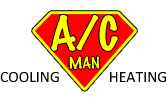Katy TX Air Conditioning Repair: A Guide On How To Properly Clean Evaporator Coils
Regular preventive maintenance is essential in making sure your air conditioner continues to work properly. You should have maintenance performed at least once per year before the cooling season begins. Season maintenance should be performed by a professional air conditioning repair Katy TX company. Tasks that should be performed include system adjustment and testing, component replacements, minor repairs, air filter changes, and cleaning condenser coils and evaporator.
The Basics Of Cleaning A/C Evaporator Coils
Check and clean the evaporator coils as needed. Monthly cleaning might be required if the coils tend to easily collect debris and dirt. Otherwise, you might need to clean them out every three months or so during the cooling season or yearly as part of your regular preventative maintenance. AC Man of Houston offers maintenance services for commercial properties.
Gaining Access To Clean The A/C Evaporator Coils
There should be an access to the indoor air handling unit that you can remove in order to get to the evaporator coil. Check your owner’s manual if necessary to find the evaporator coil and access panel. On the thermostat, turn your air conditioner off. To get the access loose, remove the screws or another type of fasteners. Set the screws and panel aside where you won’t separate or lose them. Check out our residential services by clicking here.
Using Compressed Air To Clean The A/C Evaporator Coils
- You can use compressed air to remove light accumulations of materials such as dirt by blowing them off of the evaporator coil.
- Direct the compressed air over the coil. Move in the opposite direction of regular air flow from the cleanest to the dirtiest side.
- For pieces that are more stubborn, take the air nozzle and please near the bottom part of the debris. If high-pressure air is being used, direct it either through the fins directly or at a 90-degree angle. That will prevent the fins from getting damaged.
- Maintain consistent airflow over the coil. That will dislodge the buildup without it being further forced into the fins which will make it harder to remove.
- Avoid blowing debris, dirt, and dust into the living spaces of your home or into your ductwork system. Wear eye protection so that material is kept out of your eyes. Use a shop vacuum, if necessary, to collect the material as it is being dislodged.
Using A Brush To Clean The A/C Evaporator Coils
Brush cleaning is a very effective way to remove minor dirt accumulations from the evaporator coils. It enables you to avoid having to use chemicals or liquid and provides you with greater control in terms of the amount of pressure applied to the fins and coils.
- Apply your brush to the evaporator coils to sweep away dirt accumulation.
- Use the brush to scrub and break lose materials that are harder to remove.
- Avoid using a hard-bristle brush or wire brush since the might damage the fins.
Using Commercial Cleaners To Clean The A/C Evaporator Coils
There are several commercial cleaning brands that you can use to clean evaporator coils. A majority of them are foaming kinds that break down and then drain into the drainage system of the unit. Consult with a reputable local HVAC contractor for recommendations on the best clean to use for your specific situation.
Using Water And Mild Detergents To Clean Your A/C Evaporator Coils
Instead of using a commercial cleaner, warm water and a mild detergent can be used for cleaning the coils.
- Mix a simple detergent and warm water into a spray bottle, garden sprayer or hand sprayer.
- Apply the detergent and water solution to your evaporator coils.
- Let the solution soak in for a few minutes to that it can soak in and also loosen debris.
- Use a brush or soft close to wipe away loose material.
Learn more about AC Man of Houston and our air conditioning repair Katy tx services by checking out our blog, contacting us for questions or concerns or calling us for immediate assistance.
